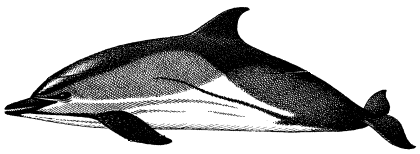
Delphinus delphis Linnaeus, 1758

Synonyms: Delphinus delphis ponticus Barabasch-Nikiforov, 1935
Common names: Engl: Common dolphin; Bulg: Obiknoven delfin, Karakash; Rom: Delfin comun; Russ: Belobochka chernomorskaya, Obyknovenny del'fin; Turk: Tirtak; Ukr: Bilobochka chornomors'ka
Order: CETACEA
Family: DELPHINIDAE
Taxonomic descriptions: It is one of two
Delphinidae species and single representative of the genus in
Black Sea cetacean fauna. The Black Sea common dolphin is
distinguished by some authorities as the endemic sub-species D.
delphis ponticus, though, obviously, many more taxonomic
studies are needed before this view can be confirmed or rejected.
According to the recent studies, the genus Delphinus
include two nominal species, the long-beaked and short-beaked
common dolphins. It is very possible that the Black Sea
population could be referred to the short-beaked species.
External distinctions: prominent beak with numerous small,
conical teeth; tall, falcate dorsal fin; hourglass-like pattern
(complex composition of grey, white, black and yellowish stripes
and areas) on both sides of the body.
 IUCN Status:
IUCN Status:
World level: DD
Black Sea Regional level: DD
Subregion level: VU in Bulgaria, DD
in Ukraine, EN in Romania
Distribution:
Habitats type, Critical habitats, Limiting factors: D.delphis is distributed predominantly offshore, but also visits precoastal waters following on seasonal aggregations and mass migrations of small pelagic fishes. Common dolphins have never been recorded in the Sea of Azov; although, they could be observed occasionally in the Kerch Strait as well as in Bosphorus and the Sea of Marmara, where they are quite common during a year except December and January. Cross-relations including both side movements between the Black Sea and Mediterranean populations seem to be possible, but no direct evidence obtained up to now. Critical habitats are not so clear as dangerous zones (e.g., Black Sea straits and forestrait areas), which could harm animals due to heavy marine traffic, fisheries and water pollution. Two natural pathogens are known to cause mass mortality events limiting the population: the lung nematode Skrjabinalius cryptocephalus and the unidentified morbillivirus. The epizootic of morbilliviral disease observed in July-September 1994 was accompanied by the stranding of sick animals.
Biology: Black Sea individuals seem to be the smallest representatives of this species anywhere in the world: the average length is 1.5-1.7 m (maximum 2.0 m) for adult females, and - 1.7-1.8 m (maximum 2.2 m) for males. According to dentinal growth layers, females and males attain sexual maturity at 2-4 and 3-4 years; the life span is 20-22 years or even more (probably 25-30 years). The mating period - late spring-early autumn - peaks in July-August. The annual pregnancy rate of the population (46-75% of fertilizing females) depends on the duration of calving intervals, estimated from 1.3 to 2.3 years. The gestation (one foetus) and lactation periods take up 10-11 and 14-19 months respectively, but calves feed on the mother’s milk only for the first 5-6 months of their life. Small pelagic fishes, forming large aggregations (sprat, anchovy, pipefish), are the basic prey for subadult and adult animals (daily ration - 4-10 kg).
Population trends: The common dolphin population still seems continuing to be the most abundant cetacean population in the Black Sea despite of its over-exploitation (mass direct kills on an industrial basis) during 1930s-early 1980s. However, this point of view is not more than a speculation circulating instead of reliable scientific data. The stock of common dolphins in Romanian waters is estimated at 600-800 individuals.
Threats: Contemporary human activities limiting the Black Sea population have not been sufficiently studied. By-catches in bottom-set gill nets are not frequent, and cases of common dolphins entangled in pelagic trawls are also unusual. Few animals were described with distinct traumatic injuries caused, probably, by mechanisms. The level of organochlorine residues in Delphinus blubber is lower than in Black Sea harbour porpoises and bottlenose dolphins. The decline in anchovy and sprat abundance (result of overfishing and accidental introduction of ctenophore Mnemiopsis leidyi) could be a reason for the conjectural difficulties in dolphins nutrition.
Conservation measures taken: The common dolphin is listed in the IUCN Red Data Book and Red Data Book of Ukraine, and all six Black Sea states have stopped commercial hunting in their waters: Turkey in 1983, other countries in 1966. This species together with other cetacean species in the region is protected by the Berne and Bonn conventions, CITES and ACCOBAMS. The UNEP Marine Mammal Action Plan and IUCN/SSC Action Plan stress that the Black Sea population is at risk. Some conservation measures are foreseen in the Strategic Action Plan for the Rehabilitation and Protection of the Black Sea (Paragraph 62).
Conservation measures proposed: Adoption of ACCOBAMS by Black Sea countries; establishment of a regional program for marine mammals research and conservation, including a monitoring study on common dolphin population.
References:
Compiled by: A.Birkun, Jr., M.Moldoveanu, M.Stanciu, T.Stanev, B.Öztürk